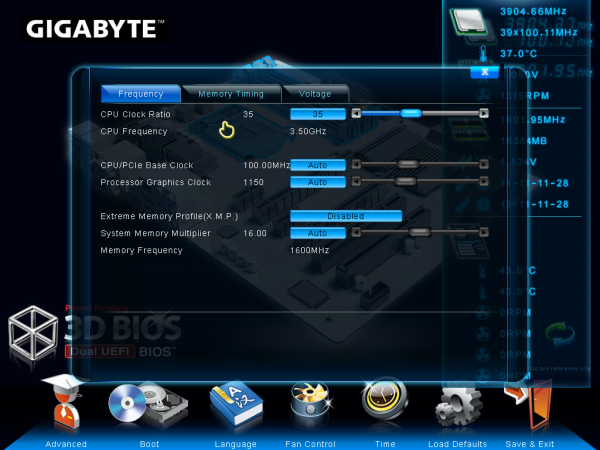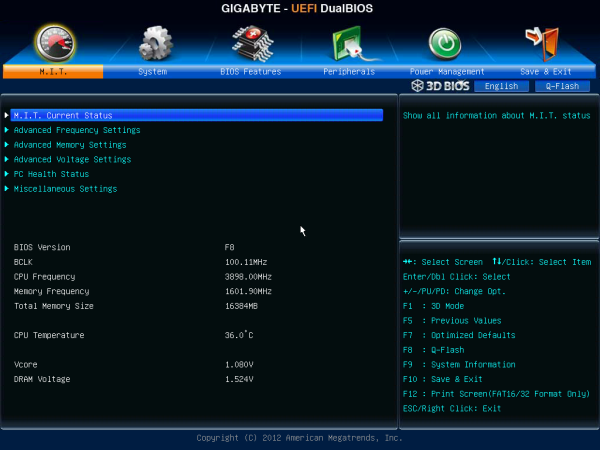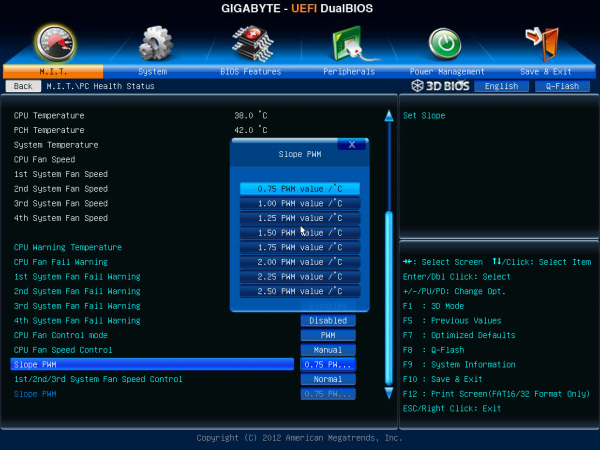Gigabyte GA-Z77X-UD5H Review: Functionality meets Competitive Pricing
by Ian Cutress on July 25, 2012 5:00 AM EST- Posted in
- Motherboards
- Gigabyte
- Z77
Gigabyte GA-Z77X-UD5H BIOS
As of late, I have been critical of the Gigabyte BIOS system. Their 3D BIOS implementation of a graphical UEFI used to be very slow to respond, and as a result made it a pig to navigate. Fast forward on a generation and our 3D BIOS is super fast, highly responsive, and more of a pleasure to use. The 3D BIOS philosophy is a little odd, as the only thing 3D about the BIOS screen is the perspective - it is still a 2D image but at an oblique angle.
The front screen of the Gigabyte BIOS uses this oblique image to act as a clickable interface for different parts of the motherboard. Users can select the CPU, the memory, the rear IO, the PCIe, the SATA connectors or the chipset in order to bring up a separate menu containing several advanced options for that area of the motherboard. This unfortunately falls down on a few areas:
Should a non-enthusiast user have this system as part of a pre-built computer (for example, my parents) and need to enter the BIOS, they will not know what to click as they do not understand what a motherboard is. I would not be able to explain 'click the SATA ports' as they do not know what SATA ports are. What we could do with here is some hover text over each part to explain what each part is in non-technical language.
In addition, as an enthusiast, my main priority of a BIOS is to manipulate and diagnose. The first screen I should see should have all the important information on it - the motherboard I am using, the CPU installed, the speed of the CPU (voltages and temperatures would be handy), the memory size, the memory speed, and other relevant data (boot sequence, hard drives). With a screen like 3D BIOS, some of this information is available straight away, and some is provided when the oblique image is clicked (see image below) but is covered by the menu brought up. For the real information, I will need to navigate through separate menus. There is enough leeway with a UEFI to be able to cater to both the enthusiast and the non-technical; it is just a shame that motherboard manufacturers still cannot get it right.
In the advanced menu, the first screen we come to is the M.I.T (Motherboard Intelligent Tweaker?). This has some valid information to greet us - BIOS version, CPU speed and voltage, memory size, frequency and voltage, and CPU temperature. The 'Current Status' option provides a longer list of exact settings, helpful for diagnosis.
Overclock options are found throughout several menus: CPU clocks and ratios are adjusted in "Advanced Frequency Settings"; memory timings and straps can be changed in "Advanced Memory Settings"; and anything relating to voltages or the 3D Power delivery options are found in "Voltage Settings". It does confuse me a little, as motherboard manufacturers have this overwhelming tendency to put options in one place only. The BIOS should be a tool that is easy to use, so why not put the voltage options for the CPU in with the CPU clocks and ratios? Or 3D Power options related to a CPU in a sub-menu in the Frequency options? The only motherboard manufacturer who is not using what is essentially a basic text and option interface right now is Intel on their own motherboards, so it does strike me as strange that no-one else is doing it.
Fan options in the BIOS are found in the M.I.T. -> PC Health Status menu, located at the bottom. Gigabyte fan controls are limited at best, especially when you compare them to the best in the motherboard arena - users here have to try to understand the options provided. The units PWM value / ºC mean nothing to everyone. Some sort of system needs to be devised here which users can input temperatures when they want the fans to idle and when they want the fans to be at 100%, and the BIOS calculates the appropriate 'PWM value/ºC' to select.
Despite my critical analysis of the Gigabyte BIOS, I found it easy to navigate by the arrow keys (my preferred method) and type in values during overclocking. It is a big step up from the first iterations of Gigabyte's 3D BIOS for sure.




















70 Comments
View All Comments
IanCutress - Wednesday, July 25, 2012 - link
As a competitive overclocker, I have used GBTL when pushing the BCLK of these boards as far as my CPU will allow (http://hwbot.org/submission/2301438_). I like GBTL - no mess and no fuss. But it is understandable why they do not include it in the Support CD, and hence why it doesn't really get a mention here. I did touch upon it very briefly in the overclocking section of the Z77X-UD3H review back at Ivy launch. As for voltage read-points, they are mentioned briefly in the board features, but I am also in agreement that perhaps the implementation of other manufacturers is more beneficial in our very niche usage scenario :)Ian
PS On the multi-board reviews I try not to take anything out from what is in a single board review. Every benchmark, test and bit of analysis in each of them gets put in :)
Nickel020 - Wednesday, July 25, 2012 - link
Oh, I missed the part about the GBTL in the UD3H review. While I haven't goten around to playing with my UD3H, I have found the Asus AI suite very practical for "normal" overclocking and I believe the GBTL will also be a real benefit for anyone working out a good 24/7 overclock. If I didn't knwo about it already I certainly would want to read about in your review if I was going to get this board for 24/7 OC.I also missed you mentioning the UD3Hs voltage read points, but in any case there's still an error in the conclusion though where you implicitly state that the UD3H does not have voltage read points (in the part about the GD65).
I know you run the same benchmarks, but I find the text/user experience more interesting than the benches, and there's definitely more text in a single board review! The benches I only care about to see whether a board has a significant performance issue, since I'm not into competitive OC I don't care about slight differences that I won't notice anyway.
Conderning the benches, I'm also a little surprised that you somewhat praise GB for auto-overclocking the CPU. IIRC Anandtech has been opposed to that in the past, since it's technically overclocking and thus theoretically voids your CPU warranty. It also makes it hard to compare board performance when CPU settings are actually the same, such as when using a manual overclock. I know it's considerably more work, but I would love to see the benches with the CPU forced to run at stock settings added to the charts, the current version is an apples to oranges comparison imho. For someone just looking at the charts (and not the text, as many do...) the current ones give a very wrong impression, they make it seem like Asus and GB perform better, when without the auto-overclock, they might actually be worse...
IanCutress - Wednesday, July 25, 2012 - link
Most users of these boards never touch the BIOS, let alone update it. This is why we run the boards at default - some manufacturers are being more aggressive with their settings and that is what you are paying for. If that aggressive setting compromises stability, then that can also be an issue. Thus it is a like-for-like comparison, as if a user was taking the boards out of the box and then just strapping in a CPU.After all, if we start changing the application of Turbo modes, what else do we change? Setting the voltage equal on each board to get a VMM reading that is always the same across the range? How about disregarding any board that uses x8/x4/x4 PCIe 3.0 against x8/x8/x4 PCIe 2.0? Default is the choice because that's what most users will end up with. Visiting some LANs recently, you would be surprised how many people buy 2133+ kits of memory and not enable XMP. That's the reality of it.
I used to be wary of this feature (as per my review of the P9X79 Pro, where I disabled it and was severely disgruntled), and still am as it results in motherboard manufacturers artificially inflating some results as to what you would expect. But this did happen before in earlier chipsets, when one manufacturer would run 100.5 BCLK, and the next would use 101.3, and even 102 BCLK, stating 'that's just how the design works'.
There's nothing we can do to change this, so I am taking the position of sitting back and analysing what they are doing, and how aggressive they are taking this philosophy. Any good reviewer will recognise what is pure statistical variation and not assign world class status to a result that is 0.01% difference.
With regards the warranty, it is a tough hammer to nail down. Would a pair of companies ever advertise that by default their settings technically breaches warranty? Or how would Intel take it, given that technically none of the cores ever went past the top turbo mode? Without a direct response on the issue, it's not worth speculating. I've known users to repeatedly successfully RMA CPUs they've overclocked on LN2 way too hard and broke them, so we don't really know if Intel will draw a line much.
Nickel020 - Thursday, July 26, 2012 - link
It's certainly a matter of opinion. As an "enthusiast" I'm of the opinion that a board should not overclock without my knowledge/express wish (since I can easily do so myself. Practically the overclock of course has no bearing on CPU warranty (the CPU also being the very last PC component that you're likely to need warranty on...).I agree that for the average user this is actually added value, a slight performance bonus at absolutely no cost other than a little bit more power consumption. Maybe point out both sides in future reviews? That way everyone's happy :)
PS: Please do fix the error in the UD3H, GD65 conclusion, it's wearing me down ;)
http://www.anandtech.com/show/5793/intel-z77-mothe...
"For the price we lose PCI and mSATA over the Gigabyte, but gain SATA, voltage read points, [...]" <--- wrong, maybe say "better implemented voltage read points"? ;)
Nickel020 - Thursday, July 26, 2012 - link
Thanks Ian :)mystikl - Wednesday, July 25, 2012 - link
No VGA port, no floppy connector, no buy .Dustin Sklavos - Wednesday, July 25, 2012 - link
Seriously?First, it does have a VGA port. Why you would want to use one escapes me now, but it's there.
Second...you still need a floppy drive and can't make do with a USB 2.0 one? Almost no modern motherboards include floppy connectors because floppy disks are horrendously outdated and that real estate can be better employed elsewhere.
mystikl - Wednesday, July 25, 2012 - link
I was actually making fun of the guy who posted the second comment! Why on earth people still need those ancient connectors is beyond me. Some may argue that some ancient software doesn't run without that specific port, but software that old doesn't require a computer with a quad core, 16 GB RAM and 3 videocards.shin0bi272 - Wednesday, July 25, 2012 - link
bios flashes on some boards still require a floppy disk... even on a quad core.SodaAnt - Wednesday, July 25, 2012 - link
Luckily those boards have floppy ports then.